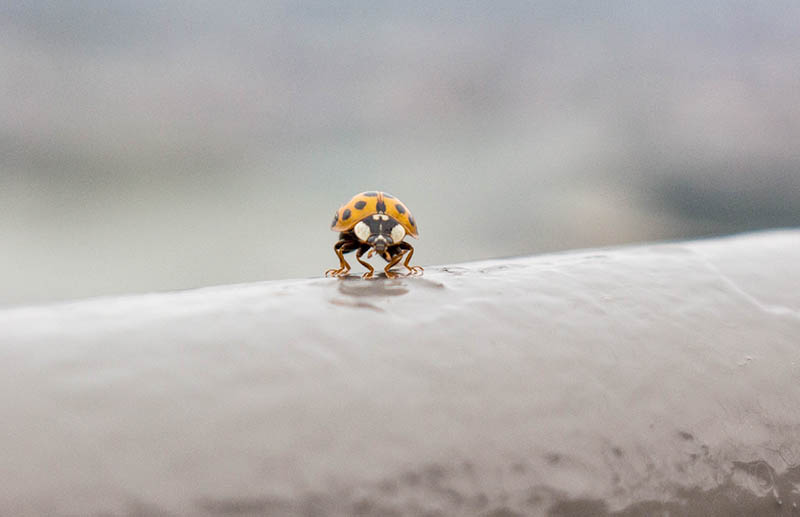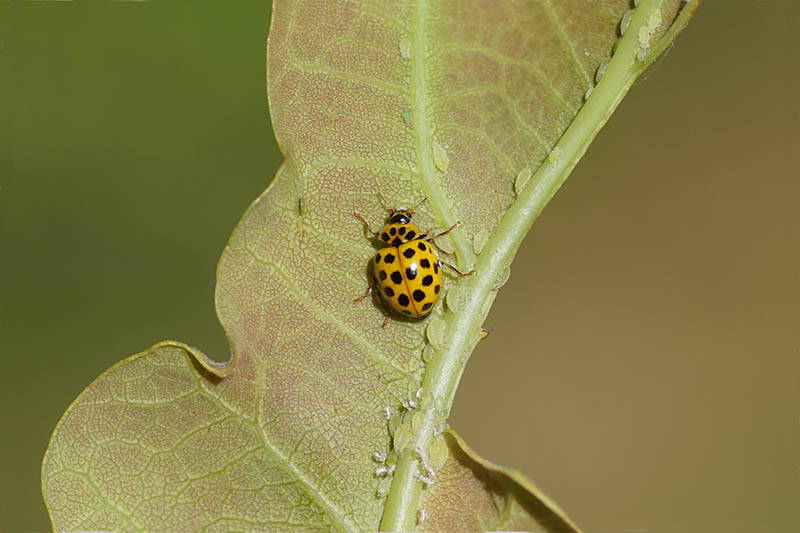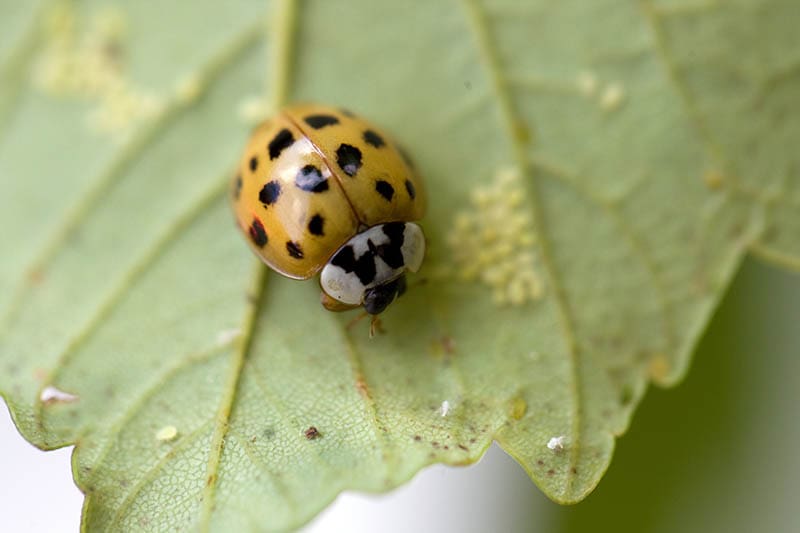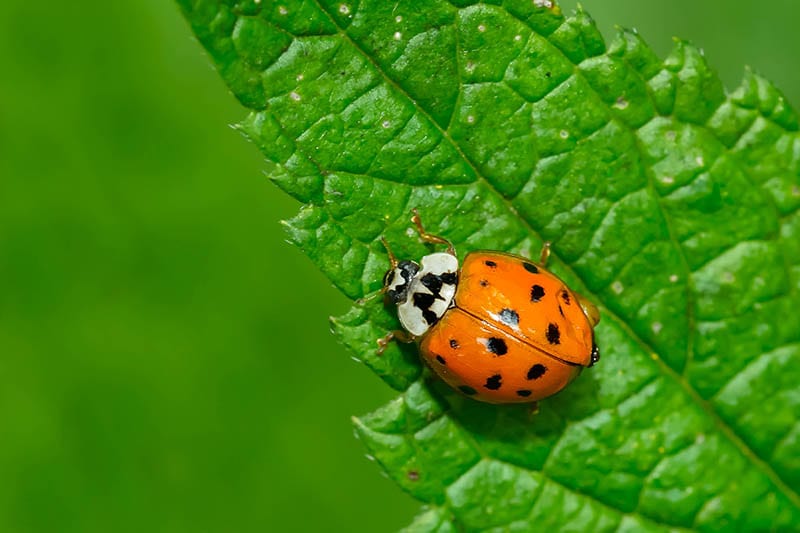Are There Yellow Ladybugs? 3 Types (With Pictures)
-
- Last updated:

We all know ladybugs for their bright red-colored bodies with beautiful spots, but did you know there are yellow ladybugs? That’s right. And no, we’re not talking about the Asian lady beetle or the cucumber beetle. Among these species include the 22-spot, 14-spot, and 16-spot ladybugs.
Stick around as we explore these rather uniquely-colored ladybugs and how to identify them.

The 3 Types of Yellow Ladybugs
With about 5,000 species of ladybugs out there, it shouldn’t be a surprise that there are some ladybugs whose bodies have colors other than the classic bright red.
As mentioned, the 14-spot, 22-spot, and 16-spot ladybug species are yellow. Let’s take a closer look at these three insects.
1. 22-Spot Ladybug

Scientifically known as Psyllobora vigintiduopunctata, the 22-spotted ladybug has a yellow body with 22 spots.
Identification
Typically, adult 22-spotted ladybugs have bright yellow (kind of like a lemon) elytra with 22 spots. Their pronotum also has an additional five spots. Usually, the pronotum is also yellow, although other ladybugs may have white ones. 22-spot ladybugs are pretty small, measuring about 3–4mm long.
22-spot ladybug late-stage larvae and pupae are also yellow and have dark markings that almost look like spots. If you are keen, you’ll notice that their spots rarely fuse with each other.
Habitat and Diet
22-spotted ladybugs are commonly found in short vegetation areas such as grassland gardens. Unlike many other ladybug species, this ladybug primarily feeds on mildew, so you may also find them in damp areas where mildew is more likely to thrive.
2. 14-Spot Ladybug

As its name suggests, the 14-spotted ladybug (scientifically known as Propylea quatuordecimpunctata) has 14 spots on its body.
Identification
14-spotted adult ladybugs have yellow wing cases (elytra), and unlike many other ladybug species, they have rectangular-shaped black spots. Normally, the spots on these insects are uniquely fused together, with some forming what looks like a smiley face in the middle of their bodies.
In some 14-spotted ladybugs, their black spots are usually fused together so much that it may look like they have black bodies with yellow spots.
Their pronotum is yellow or cream color with black spots. Again these spots are uniquely merged together, forming a trapezium or crown shape. 14-spotted ladybugs are tiny, measuring about 3.5–4.5mm long.
It’s easy to confuse the 14-spotted ladybug with the 22-spotted one. However, the 22-spot ladybug’s yellow elytra is brighter than the 14-spot ladybug’s elytra. What’s more, the 22-spotted ladybug has more circular and spaced-out black spots compared to the 14-spotted ladybug.
Habitat and Diet
14-spotted ladybugs are inhabitants of low vegetation areas. However, they can be found in various places, from parks to meadows, rotting plants or woods, and even compost. Like many other ladybug species, these insects are omnivorous, feeding on various crop pests like aphids and plants.
3. 16-Spot Ladybugs

While 16-spotted ladybugs (Tytthaspis sedecimpunctata) aren’t that yellow, their bodies tend to have a yellowish hue as they age.
Identification
Typically, their bodies are beige or cream with black spots, with most of them merged. One of their distinctive features is the line on either side of their bodies, formed by several spots fused together. They are also small, measuring approximately 2–3mm long.
Habitat and Diet
16-spotted ladybugs can be found in grasslands, marshy or dry meadows, rotten tree logs, and plants. This ladybug species is one of the few that feed on a lot of things. Usually, these ladybugs feed on nectar, pollen, and fungi (rust fungus). They also feed on mites and aphids.

Other Ladybug Species With Yellow ladybugs
Apart from the above ladybug species, there are others that may have yellow ladybugs. Let’s look at some of them.
Asian Lady Beetles

Asian lady beetles (Harmonia axyridis) are a ladybug species with brightly-colored bodies ranging from bright orange to red with black spots.
Orange-colored Asian lady beetles may look like they are yellow, but there are several differences between them and common yellow ladybugs. For starters, they are larger than other ladybugs. Also, they have oval-shaped bodies, while common ladybugs have round bodies.
Squash Beetles
Squash beetles are under the Coccinellidae family in the animal kingdom classification, so they are scientifically classified as ladybugs. These insects have bright yellow-cream-colored bodies with seven large black spots on each elytron and four small black ones on their pronotum.
Similar to Asian lady beetles, these insects are a bit larger than most common ladybug species.

Are Yellow Ladybugs Toxic?
Like all the other ladybugs, yellow ladybugs are not poisonous. However, species like the Asian lady beetle, which have a yellowish color, are known to trigger allergic reactions in some individuals.

Final Thoughts
As we pointed out earlier, there are lots of ladybug species, with many of them not having the regular bright red color we associate ladybugs with. So, a yellow ladybug isn’t something out of the ordinary.
However, it’s important to keep in mind that there are “harmful” beetles that look very similar to yellow ladybugs, so color isn’t enough to identify a ladybug. What’s more, most ladybug species are yellow when they first transform from their pupal stage. They then gain their natural color as they develop into full adults.
Featured Image Credit: JumpStory
Contents

